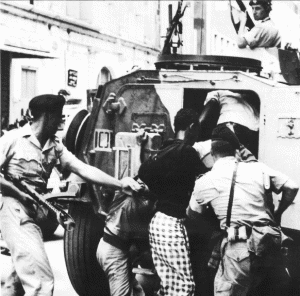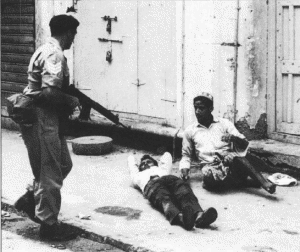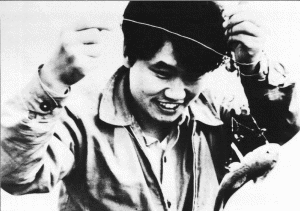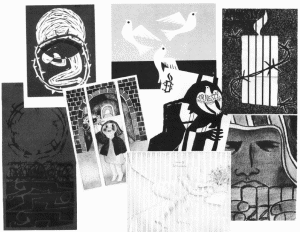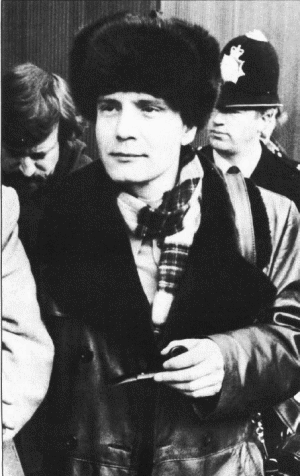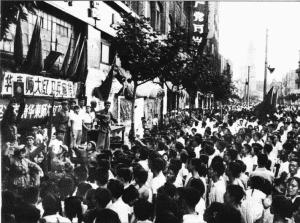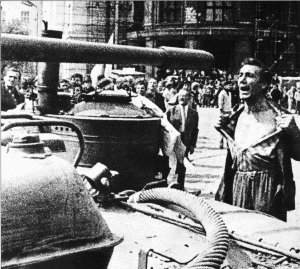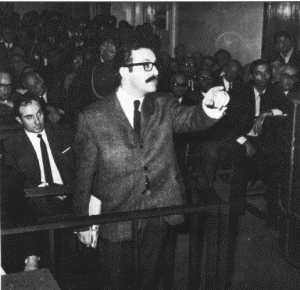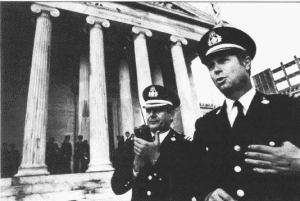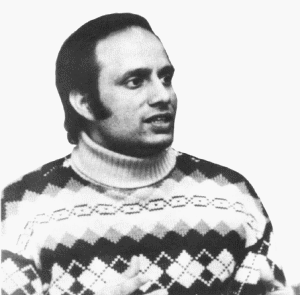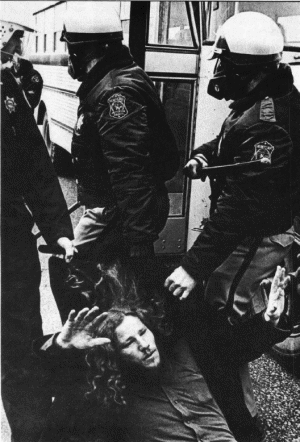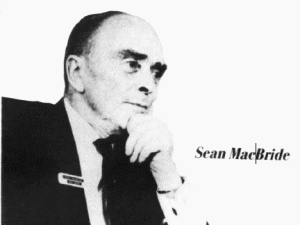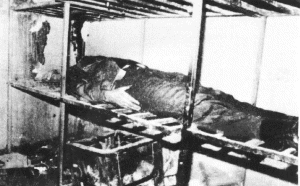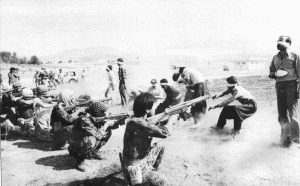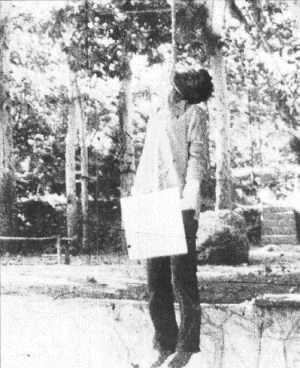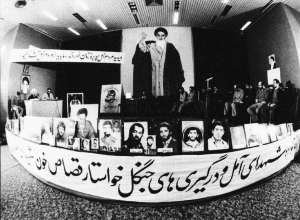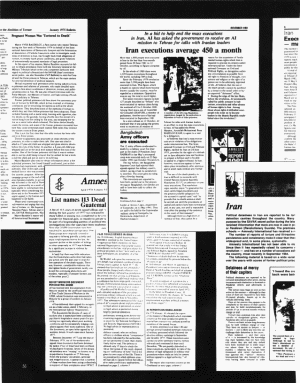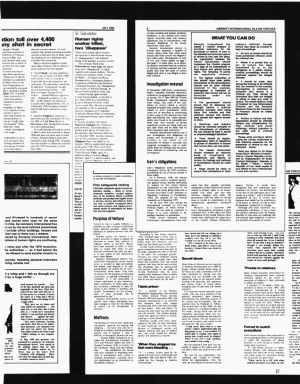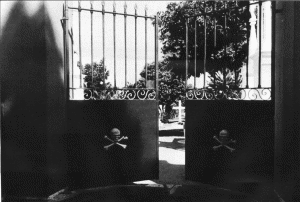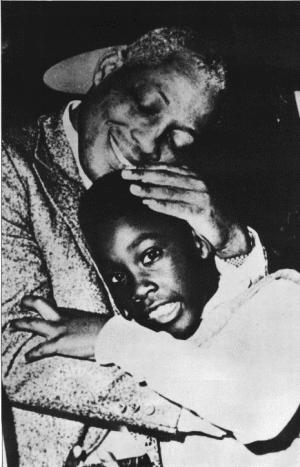ILL-TREATMENT IN NORTHERN IRELAND Following the introduction of internment in Northern Ireland in 1971, Amnesty International investigated allegations that suspects were being subjected to ill-treatment by security forces. A fact-finding mission concluded that the medical evidence was consistent with the claims made by former detainees interviewed. Amnesty International published its findings and made recommendations to a government inquiry. The torture techniques -- which in some cases caused long-term psychological harm -- were dropped. Six years later the European Court of Human Rights ruled that the interrogation methods violated Article 3 of the European Convention on Human Rights which prohibits 'cruel, inhuman or degrading treatment or punishment'. The first of the following extracts comes from Amnesty International's 1971 submission to the government inquiry into interrogation techniques (the Parker Committee). The second is from 'Torture in the Eighties' (1984) and examines the situation in Northern Ireland in the late 1970s.
It is said that the physical ill-treatment described in the Compton Report [report of a government Committee of Enquiry into allegations of ill-treatment] is less severe than the methods of ill-treatment used by other regimes in other countries. But this should not serve to disguise or blind us to the true nature of the procedures described in the Compton Report. There is a danger that even by considering the procedures at length we become anaesthetized to the degree to which they constitute an offence against the person. It is a form of torture to force a man to stand at the wall in the posture described for many hours in succession, in some cases for days on end, progressively exhausted and driven literally almost out of his mind by being subjected to continuous noise, and being deprived of food, of sleep, and even of light.
But the moral impropriety of these techniques principally derives not from their physical effects at all, but from the fact that they constitute a grave assault on the human mind. It is clear that the purpose and effects of these techniques is to disorientate and break down the mind by sensory deprivation. If we regard the physical ill-treatment as merely a means to achieve the same effect as would be achieved by the forcible injection of an hallucinatory drug or of a drug designed to break down and disorientate the mind, we begin to appreciate the true nature of the moral offence committed. It is because we regard the deliberate destruction of a man's ability to control his own mind with revulsion that we reserve a special place in our catalogue of moral crimes for techniques of thought control and brainwashing.
Case History: Patrick McKavanagh Age: 24 years 1. The Commission heard oral evidence from Mr. McKavanagh and read a medical statement by Conor J. Gilligan, MB, FRCS, Mater Infirmorum Hospital, Belfast. The case was presented by Mr. Francis Irvine, solicitor.
2. Mr. McKavanagh says that he, his brother William, and Edward Rooney, met a military patrol on Catherine Street at about 2 a.m. on 11 August 1971. They were ordered to halt but William McKavanagh turned to run, was shot and died some minutes later. Mr. Patrick McKavanagh and Mr. Rooney were placed under arrest. An army vehicle arrived at about 6.30 a.m. and they were taken to Hastings Street Barracks. The body of Mr. McKavanagh's brother was taken in the same vehicle.
Mr. McKavanagh was later taken to the Police Office on Townhall Street and charged with theft (he had taken up a rivetting tool, a pair of boots and some socks that were lying on the street during the disturbances -- and kept them) and appeared in court on 12 August 1971 and was released on bail. No other charges were preferred against him. He was examined by Mr. Gilligan on 12 August.
3. Mr. McKavanagh alleges the following: He was struck in his face by a baton or a rifle butt when he entered the army vehicle. His glasses were smashed and a soldier trampled on them deliberately. Both McKavanagh and Rooney were verbally abused and they were also threatened that they would be beaten up and shot. Mr. McKavanagh was further beaten with batons and rifle butts.
In the barracks he was made to stand spreadeagled against a wall, finger tips against the wall and legs forced back and out. He was hit repeatedly. This went on for about twenty minutes. After this he was forced to do exercises and was hit on the head and elbows. An empty sand bag was put over his head for about half an hour and he found it hard to breathe. When he was interrogated later he was tapped from behind on the back of the head. He was first given the diabetic medicine, which he should take three times a day, at about 8 p.m. on 11 August.
4. On examination, Mr. Gilligan found a bruised swelling on the bridge of the nose with the skin broken in centre. There were tender swellings close to the left ear, on the right parietal area, on the right arm and in the neck. There were several extensive areas of swelling and bruisings on the limbs. There was especially extensive bruising on the right thigh and the skin was broken, which could have been caused by an instrument or a weapon with a sharp point. there was evidence that he had been struck repeatedly over different parts of this body by a blunt weapon, used with considerable force.
In Mr. Gilligan's opinion, the injuries he observed were consistent with Mr. McKavanagh's account of how they were inflicted.
5. Conclusion: The Commission finds no major inconsistencies in Mr. McKavanagh's testimony and his account is essentially corroborated by the evidence from Mr. Rooney regarding experiences when the two were together. The Commission, having considered the evidence given by Mr. McKavanagh and Mr. Gilligan, accepts the substance of Mr. McKavanagh's allegations.
Published March 1912
'TORTURE IN THE EIGHTIES': NORTHERN IRELAND In January 1976 the European Commission of Human Rights in Strasbourg concluded that the authorities in Northern Ireland and the British Government were responsible for practices in 1971 amounting to torture and inhuman treatment of detainees under interrogation by the police, in breach of Article 3 of the European Convention on Human Rights. [1] In the meantime, the British Government gave the British Parliament in 1972 and the European Court of Human Rights in 1977 unqualified undertakings that the most objectionable techniques of interrogation would not be used again. Yet despite this declared concern, (which led the European Court to state in 1978 that it was hardly plausible that practices in breach of Article 3 would continue or recommence), complaints of assault during interrogation in early 1976 in Northern Ireland were increasing.
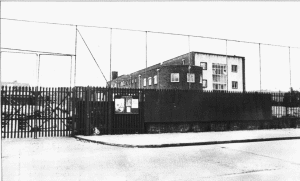 Castlereagh interrogation centre in Belfast, Northern Ireland, one of the places where political suspects were tortured.
Castlereagh interrogation centre in Belfast, Northern Ireland, one of the places where political suspects were tortured. 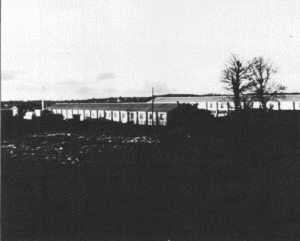 The Maze prison, Belfast, Northern Ireland. A pattern recurs
The Maze prison, Belfast, Northern Ireland. A pattern recurs Between 1976 and 1978, one in 11 detainees arrested under emergency legislation in Northern Ireland filed official complaints of assault by the Royal Ulster Constabulary (RUC). [2] Prior to May 1977 almost all such complaints came from members of the Roman Catholic community, detained as 'Republican' suspects. Starting in May and June, with the advent and collapse of a Protestant-led strike, 'Unionist' detainees also began to file complaints.
The 443 complaints of assault during interrogation filed in 1977 represented a 101 per cent increase over 1976, although fewer suspects were detained. An Amnesty International mission to Northern Ireland in late 1977 investigated 78 cases, both 'Republican' and 'Unionist'. It found that ill-treatment by the RUC had taken place. The alleged methods included such physical and psychological abuses as beatings, bending of limbs, prolonged standing, burning with cigarettes, threats of death and threats to the suspect's family. [3]
It is important to ask why the preventive measures taken and assurances given by the British Government, following the exposure by Irish and British journalists (and by Amnesty International) of the torture of 14 detainees and the ill-treatment of hundreds more in 1971, did not prevent the assault of suspects from becoming a frequent and tolerated practice in Northern Ireland from late 1975 or early 1976 until early 1979 and to examine what steps were taken to reduce the number of complaints so significantly by 1980.
The law and interrogation Northern Ireland security needs in 1972, in the British Government's view, dictated a review of arrest and trial procedures. The officially appointed Diplock Commission recommended changes that became law in the Northern Ireland (Emergency Provisions) Act 1973, which altered the rules of evidence for the admissibility of confessions. In English and Northern Ireland common law a judge can allow in evidence only a voluntary statement made by the accused, 'in the sense that [it has] not been obtained from him by fear of prejudice or hope of advantage, exercised or held out by a person in authority, or by oppression'. [4] The Diplock Commission concluded that this common law test was 'hampering the course of justice in the case of terrorist crimes', [5] and the 1973 Act altered the test of voluntariness. Whereas the common law test renders inadmissible confessions obtained by 'oppression', section 6 of the 1973 Act had the effect of disallowing confessions only if the accused 'was subjected to torture or to inhuman or degrading treatment'. [6] Since the 1973 Act applied only to Northern Ireland, the police in the province became exempt from restraints applying elsewhere in the country. Although the Diplock recommendations and the new act did not specifically make physical violence or psychological coercion lawful, they did imply that a confession previously disallowed by judges due to police misconduct in obtaining it might henceforth be admitted in evidence. Furthermore, Lord Diplock recommended that the law prohibit the threat of physical violence, but this prohibition was not included in the 1973 Act. The omission could only encourage the view that a degree of coercion would be tolerated.
Until late 1975 this change in law did not significantly alter police interrogation practices. Prior to this time the security strategy of the government was based either on executive internment without trial or on quasi-judicial internment regulated by commissioners. either system required a high level of proof to ensure a suspect's continued detention. Indeed, the purpose of these systems was to put suspected terrorists or their sympathizers out of action even when there was not sufficient evidence to convict them in a court of law. As internment was phased out gradually during 1975, however, evidence became essential to the conviction of terrorist suspects in the trials that Lord Diplock had recommended to replace internment. In Northern Ireland forensic evidence is difficult to obtain in hostile areas. Witnesses are subject to fear and intimidation. Intelligence information, whether from informers or detainees, until recently has rarely been used in court. Under these circumstances, the RUC came to rely almost exclusively on confessions as evidence against the accused. For example, during the first half of 1978, 75-80 per cent of all convictions for politically motivated offences were based solely or mainly on confessions. [7]
Between 1972 and 1975 there were allegations of ill-treatment during interrogation, but the numbers were few and no pattern emerged. The need to get confessions for convictions in court, however, brought changes in 1976. The RUC took over from the army in all but the most hostile neighbourhoods. New RUC crime-squads were formed to specialize in interrogation. Centralized police interrogation centres were opened or planned at Castlereagh police station in Belfast and Gough Barracks in County Armagh. In July, the new Chief Constable, Kenneth Newman, issued an internal directive that made an important distinction between the 'interview' of a suspect, which would lead to a specific criminal charge and to which common law protection of the Judges' Rules on admissibility of evidence would apply, and the 'interrogation' of suspects, which was for general questioning and gathering intelligence. By implication, because this more general questioning need not lead to a charge for a specific offence, the Judges' Rules need not apply. Since available evidence indicates that approximately two-thirds of those arrested in Northern Ireland under emergency legislation at that time were released without charge, [8] this relaxation (or implied suspension) of the Judges' Rules and of the protection they afford suspects had special significance for 'interrogations'. During 1976 complaints of assault during interrogation increased by approximately 85 per cent over 1975, whereas arrests increased by only 49 per cent.
The government's view of interrogation Successive British governments throughout the 1970s had a common policy on interrogation: to protect police discretion to question a suspect in private for extensive periods without the intrusion of the courts, lawyers or any other independent person. One consequence of this policy was the failure to safeguard suspects' rights and physical integrity. Besides relaxing the rules governing the admissibility of confessions in court, the government gave the police new powers in 1973 to hold persons suspected of politically motivated crimes incommunicado for up to three days (increased to seven days under the Prevention of Terrorism (Temporary Provisions) Act, 1974).
A prominent factor in the rapid decline in police standards was the prolonged failure of government ministers and senior RUC officers to intervene with interrogators, directly and forcefully, to show that assault and illegal coercion would not be tolerated. On the contrary, the increased number and seriousness of complaints in 1976 and 1977 came when the government was pressing the police for confessions to use in court. Since the 1971 Compton Committee (which actually justified the use of the interrogation techniques subsequently identified as torture by the European Commission of Human Rights), no government-initiated inquiry has specifically investigated allegations of ill-treatment in Northern Ireland. All such inquiries have dealt with legal or police procedure, not with individual allegations of brutality. No British government took any decisive action before 1979 to halt the abuses that had begun to increase three years earlier, and to this day (to Amnesty International's knowledge) no government minister having responsibility in this area has accepted that ill-treatment took place in the late 1970s.
The extension of police discretion Nor did the RUC command intervene despite the increasing evidence of misconduct by plain-clothes detectives in the middle and lower ranks. In April 1977, a senior police surgeon wrote to one of the government authorities, complaining that although police surgeons forwarded reports on a prisoner's injuries to the appropriate police station, 'no senior officer has ever seen fit to ring up to see me or my colleagues about the injuries noted.' [9] Several police interrogators were found at fault in civil proceedings, and the Police Authority chose to settle other claims out of court. In some instances these complaints were of serious assault and the damages paid were substantial. Yet no police officer ever admitted ill-treating a suspect, and no internal disciplinary proceedings were brought against any police officer.
The RUC took the position that allegations against its officers were part of an orchestrated campaign to sully the reputation of the force throughout the community, thereby damaging its aim of gaining acceptance for its law-enforcement role, especially by the Roman Catholic community, and thus reducing its effectiveness against paramilitary groups. In the official RUC view the injuries sustained by prisoners were either self-inflicted or resulted from attacks made by the detainee on police officers, who then had to restrain the suspect. Chief Constable Newman asserted in June 1977 that the increasing number of allegations of police brutality were a sign, not of police misconduct, but of growing police success in combating terrorism. He also pointed out, correctly, that suspects had strong motives to file false complaints of assault against their interrogators. They might need to justify their confessions to their own paramilitary groups, and their only defence in court was often to claim that their confessions had been extracted under torture, or inhuman and degrading treatment. If the confession could be ruled inadmissible on that statutory ground, under section 6 of the 1973 Act, the accused would probably go free since it was usually the only evidence available.
The legislation earlier in the decade had increased police powers without providing for corresponding safeguards to protect the rights of suspects. The RUC sought (and were allowed) to increase police discretion over the interrogation process, violating the common law principle of access to a lawyer and undermining the machinery for the investigation of complaints against the police. None of the 78 people whose cases of alleged ill-treatment were examined by the Amnesty International mission in 1977 had been allowed to see a lawyer while in police custody. The majority of them had specifically requested to see a lawyer soon after arrest. The Judges' Rules state that 'every person at any stage of an investigation should be able to communicate and to consult privately with a solicitor (lawyer) ... provided that in such a case no unreasonable delay or hindrance is caused to the process of investigation ...', but this latter proviso was invariably interpreted by RUC officers so as to deny access to a lawyer. Detainees spent as many as seven days in incommunicado detention. It appears that the discretion assumed by RUC investigating officers to exclude lawyers was not the practice at this time elsewhere in the United Kingdom. [10]
Concerning complaints machinery, the RUC frequently pointed out, correctly, that it was more elaborate in Northern Ireland than anywhere else in the United Kingdom. However, the oversight role of the independent Police Authority does not cover complaints of criminal assault, which are referred to the Director of Public Prosecutions (DPP). Furthermore, the DPP does not have an independent investigative staff, and all complaints against the police are investigated by the RUC itself. Chief Constable Newman often argued that the DPP's decision not to prosecute a police officer was an indication that the allegations were false. In fact, the DPP himself reminded the Chief Constable in November 1977 that the failure to bring a prosecution against a police officer did not indicate that the complaint itself was untrue. In a review of 300 complaints from the first nine months of 1977, wrote the DPP, he had found some evidence of assault in about half of them, some of which were medically documented. But he had found a level of evidence high enough to make conviction possible, and therefore to warrant prosecution, in only one case.
The government-appointed Bennett Committee found that from 1972 until the end of 1978 only 19 police officers were criminally prosecuted for ill-treating terrorist suspects out of the hundreds of complaints that had been filed. Of these 19, only two were convicted, and both these convictions were set aside on appeal. In five of the cases resulting in acquittals, civil proceedings in respect of the same incidents resulted in the police paying damages to the complainants. [11]
The main reason for this low number of prosecutions was that in order to bring a prosecution, the DPP must be satisfied -- beyond reasonable doubt -- that the assault was committed by an identifiable police officer and can be proved in court. Nevertheless, Chief Constable Newman continued to maintain that the general lack of prosecutions cleared the RUC of allegations of misconduct. In other words, no crime had been committed because the officers responsible could not be convicted.
The judiciary In ordinary circumstances one would expect judges in the United Kingdom to provide a measure of protection to suspects by their rulings on arrest and interrogation procedures. Given their independence as well as the degree of discretion allowed judges in English and Northern Ireland common law, it is fair to ask why cruel, inhuman and degrading treatment took place in spite of the role and authority of the Northern Ireland judiciary.
The primary role of the judiciary in the UK, according to the Judges' Rules, is to 'control the conduct of trials and the admission of evidence ... ; they do not control or in any way initiate or supervise police activities or conduct.' Nevertheless, the courts' decisions do influence police practices indirectly by indicating, after the fact, what kind of conduct by the police makes evidence inadmissible in court. In Northern Ireland interrogating officers attend trials of terrorist suspects regularly in order to give evidence, and they do take note of the attitude of the courts. The Bennett Report cites the evidence of an officer who testified in a civil proceeding that because the courts had accepted confessions made after 'interviewing hours on end with no sleep', he continued to interrogate prisoners in this way. [12]
One means of protecting detainees' rights during interrogation left unused by the courts is to disallow confessions obtained during incommunicado detention. Principle (c) of the Judges' Rules, cited earlier, protects the right of access to a lawyer. Although it can be argued that section 6 of the 1973 Act negated this principle in Northern Ireland, Mr Justice Bennett, citing police practice and court precedents elsewhere in the United Kingdom in 1977, implied that discretion was still available to Northern Ireland judges to exclude confessions obtained after the police had denied a prisoner's request to see a lawyer. In no case in Northern Ireland involving people charged under emergency legislation did judges exercise this discretion. 13 In effect, judges did not help to ensure the detainee's right of access to a lawyer, which they could have done by disallowing evidence obtained during incommunicado detention, some of which was allegedly the result of ill-treatment.
More extreme assaults, especially if medically documented, presented judges with little difficulty in disallowing the confession of the accused. But in less clear-cut cases the Northern Ireland judiciary seemed uncertain of their authority to intervene positively. Several Northern Ireland judges attempted to interpret the degree of judicial discretion over disallowing from evidence confessions obtained by coercion that in their view was short of torture and of inhuman or degrading treatment (the language of section 6 of the 1973 Act). After reviewing some of these judgments the Bennett Committee found that 'the uncertainty, despite the standards upheld and applied by the courts, about what is permissible and what is not ... may tempt police officers to see how far they can go and what they can get away with.' [14] The police interrogators appear to have interpreted the judges' too frequent silence as assent.
Pressure from the police surgeonsThe most striking single action taken by any official in Northern Ireland to prevent ill-treatment was Chief Constable Newman's order on 21 April 1978 to install 'spy-holes' in the doors of interview rooms at the Gough Barracks interrogation centre so that senior officers could monitor interrogations. The suggestion came from the Senior Medical Officer (SMO) at Gough, Dr Denis Elliott, who had held a long-awaited meeting with the Chief Constable the previous night to discuss prisoners' injuries that doctors were continuing to see. During the next five months there were no complaints of assault filed by prisoners interrogated at Gough for terrorist offences.
Also in attendance at the meeting in April were Dr Charles Alexander, SMO at Castlereagh police station in Belfast, and Dr Robert Irwin, Secretary of the Forensic Medical Officers Association, who had himself seen many injured detainees from Castlereagh. Since late 1976 doctors employed by the independent Police Authority or by the government's Department of Health and Social Security (DHSS) as police surgeons had documented injuries that they were convinced could not be dismissed as self-inflicted. In March 1977 Dr Irwin's association informed the Police Authority of its concern about the increasing number of injuries to prisoners. Both individual doctors and groups of doctors kept pressing their employers and the RUC to respond to their demands. They cited the decision of the European Commission of Human Rights about the 1971 events, which was still under consideration by the European Court, as cause for doctors to play an active role in protecting prisoners from abuse and the police from false allegations.
The doctors kept their appeals within the system's administrative channels, shunning publicity. In the wake of a national television program about Castlereagh, however, having failed for months to get a personal interview with the Chief Constable, their association's executive committee stated publicly in October 1977 that they had sought a meeting with him to discuss injuries to detainees. In November, doctors at Castlereagh and Gough informed their employer that they would resign unless action were taken to stop the assaults. When taking up his post as SMO at Gough on I November, Dr Elliott stipulated that if there were serious police misconduct towards detainees, he would request a transfer to his previous post. The cumulative pressure of the national television program, the visit of the Amnesty International mission to the province in late November and early December 1977 and the doctors' steadfastness appears to have had an impact. Complaints of assault during interrogation dropped from the autumn 1977 average of 40 a month to eight in December. The association's representatives noted this improvement in their discussions with the Amnesty International mission in December as an explanation of why the mission had examined released prisoners with recent but not fresh injuries.
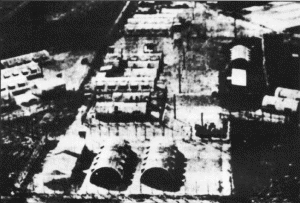 After thorough investigation, Amnesty International declared that the British Army practised torture on political detainees in Northern Ireland. Until 1975 hundreds of people were imprisoned under very harsh conditions without being brought to trial or being sentenced. In Long Kesh camp many prisoners were detained without trial from 1971 to 1975.
After thorough investigation, Amnesty International declared that the British Army practised torture on political detainees in Northern Ireland. Until 1975 hundreds of people were imprisoned under very harsh conditions without being brought to trial or being sentenced. In Long Kesh camp many prisoners were detained without trial from 1971 to 1975.In March 1978 the Police Authority informed the government that the doctors had noted a renewed pattern of injuries, that resignations might soon follow, and that the doctors wished their assessment of the recent decrease in injuries given in December to Amnesty International to be withdrawn. The next month Dr Irwin's association wrote formally to the Police Authority on this last point; four doctors at Gough, where Dr Elliott was SMO, wrote to the Police Authority in order to protest against the continuing injuries in custody, and Dr Elliott himself formally requested a transfer. Their pressure seems to have conveyed a sense of urgency to the government and the RUC command. The Amnesty International mission had collected considerable medical evidence, and a report would soon appear. Resignations at this time by police surgeons would have been an acute embarrassment to the government. Chief Constable Newman met Drs Alexander, Elliott and Irwin on the evening of 20 April and took decisive action the next morning. Besides the new 'spy-holes' to be installed, the meeting discussed a suggestion to install closed-circuit television in interrogation rooms so that senior officers could monitor interrogators' conduct. The Chief Constable objected that this would be costly, to which Dr Irwin replied that it would be cheaper than having to return to the European Court.
Amnesty International published its report in June 1978. The immediate result was the government's appointment of the Bennett Committee of Inquiry into police procedures which ultimately led to the introduction of administrative safeguards to protect detainees and to a drop in the number of complaints of ill-treatment.
In August a new job description was agreed for police surgeons which formally extended their duties. SMOs would henceforth have access to any prisoner at all reasonable times, not just when the police called them in, and they would occasionally tour the police station, making use of the new 'spy-holes'.
During the remainder of 1978, while the Bennett Committee received evidence, complaints of assault declined but did not cease. Their report was published in March 1979 and their major recommendations were accepted by the government in June. But the Bennett Report did not lay the doctors' fears to rest. A few days before its publication Dr Irwin broke the doctors' long public silence and gave a nationally televised interview. He described some of the 150 injured prisoners he had personally examined - injuries he believed were not self-inflicted - during the past three years, some as recently as the month before. One week after publication of the Bennett Report, Dr Elliott resigned in protest at the 'undisciplined' treatment of prisoners at Gough and at the failure of either the government or the RUC to acknowledge that ill-treatment had occurred during the past three years. Drs Elliott and Irwin, whose actions had done so much to bring about an official inquiry, now underlined the importance of its recommendations.
The significance of an independent inquiryThe Bennett Committee addressed the balance between the efficiency of police interrogation and the protection of suspects' rights. Its terms of reference prevented an investigation of individual complaints. Nevertheless, it examined considerable medical evidence that revealed 'cases in which injuries, whatever their precise cause, were not self-inflicted and were sustained in police custody'. Nor did the government permit a general review of the emergency legislation or a specific one of section 6 of the 1973 Act. Such a review might have led to recommendations for statutory protection of prisoners. Given these restrictions, the committee recommended self-regulation by the police: for example, closed-circuit television monitoring of interrogations by senior officers; more detailed record-keeping on detainees; and the offer of a medical examination once every 24 hours. Even the recommendation for access to a lawyer after each 48 hours in custody, without exception, was to be incorporated in a revised RUC code of conduct, rather than in legislation. The report thus offers an impressive set of preventive administrative measures that, if fully implemented, would significantly reduce the likelihood of torture or ill-treatment of suspects.
Once implemented, these measures did reduce the number of allegations of assault and ill-treatment in Northern Ireland. The average number of complaints filed in the first three months of 1979 was 20 a month. This was somewhat down on the 1978 monthly average of 22, but in April 1979, the first full month after the Bennett Report appeared, the number of complaints dropped sharply to 8.15 More significantly, the administrative measures introduced seem to have prevented the recurrence of the previous pattern of ill-treatment.
At present a very high percentage of convictions in non-jury trials in Northern Ireland are based solely or mainly on confessions. However, Amnesty International's approaches to the British Government about current police and judicial procedures used in Northern Ireland have not concerned allegations of ill-treatment. They have concerned the use of continuous, oppressive interrogation, which has resulted in a steadily high rate of confessions for which no objective corroborating evidence is presented in court. Under these conditions it is doubtful whether the 48-hour rule concerning absolute right of access to a lawyer provides adequate protection for detainees under interrogation.
There are several generalizations to be drawn from this examination of ill-treatment in Northern Ireland in the late 1970s:
1. The attitude towards the treatment of detainees shown at the top of the command structure within a security agency and by ministers responsible for their conduct affects officers' attitudes and actions right down the line.
2. Emergency legislation (or the interpretation of existing law by the courts) that extends the powers of the security forces specifically at the expense of detainees' legal guarantees may be perceived by the security forces as a signal that the law, the government and the courts will tolerate official violence towards and coercion of detainees.
3. When emergency legislation extends the powers of the executive, the judiciary must increase its vigilance on behalf of suspects and defendants if their rights are to be protected.
4. Post-facto investigations, prosecutions, civil suits and internal disciplinary proceedings may not be sufficient by themselves to stop abuses. The responsible authorities must take direct preventive actions, particularly those measures that will guarantee detainees access to individuals independent of the security forces, for example, the detainees' lawyer, doctor and relatives. This is all the more true in a legal system that does not provide for contemporaneous judicial supervision of interrogation.
5. Organized pressure from within the security system for respecting the rights of suspects is most likely to be effective when complemented by external pressures, in particular from the news media, which in some societies can play a relatively independent watchdog role in bringing alleged abuses of authority to public attention.
6. The existence and use of inter-governmental human rights machinery, although lengthy and capable of being obstructed by a government, can act as a restraint on human rights abuses if the government fears the findings, the expense, the embarrassment or even the propaganda that may result.
1. European Commission of Human Rights, Report of the Commission on Application No. 5310/71, Ireland against the United Kingdom of Great Britain and Northern Ireland, adopted 26 January 1976, pp. 402 and 468. The European Court of Human Rights, in their judgment on this case in January 1978, modified the Commission's findings, omitting the word 'torture' but confirming that there had been an 'administrative practice' of inhuman and degrading treatment in breach of Article 3. For a discussion of the significance of this judgment in international law, see Chapter 2 to this report, page 15.
2. This ratio is calculated on the basis of data given in the Report of the Committee of Inquiry into Police Interrogation Procedures in Northern Ire/and (hereafter called Bennett Report), HMSO London, Cmnd. 7497), paragraph 44 and Appendix 2. The ratio given in paragraph 313 of the Bennett Report (one in eight detainees held under emergency legislation filing complaints of assault during interrogation between 1975 and 1978) appears to be erroneous in that this calculation is based on the number of complaints by all detainees in Northern Ireland, not just by those held under emergency legislation.
3. Amnesty International, Northern Ireland: Report of an Amnesty International Mission (London, 1978), p. 4 (hereafter called Amnesty International Report on Northern Ireland).
4. Judges 'Rules and Administrative Directions to the Police, Home Office circular No. 31/1964, principle (e). The Judges' Rules are in the form of advice to police officers on what will and will not be allowed as evidence in a trial.
5. Report of the Commission to consider legal procedures to deal with terrorist activities in Northern Ireland (hereafter called Diplock Report), (HMSO London, Cmnd. 5185, December 1972), paragraph 87.
6. The phrase quoted from section 6 was taken verbatim from Article 3 of the European Convention for the Protection of Human Rights and Fundamental Freedoms. Section 6 of the 1973 Act became section 8 in the consolidated version of this act in 1978.
7. Bennett Report, paragraph 30. The figures were prepared by the Director of Public Prosecutions for Northern Ireland and were thought by the Bennett Committee to be accurate for 1976 and 1977 as well.
8. Bennett Report, appendix 1, gives precise statistics for September 1977 until August 1978: only 35 per cent of those detained were charged.
9. Letter of 14 April 1977 from Dr Robert Irwin, Secretary of the Forensic Medical Officers Association in Northern Ireland, to Dr Terence Baird, Chief Medical Officer at the Department of Health and Social Security, Belfast. Quoted in Peter Taylor, Beating the Terrorists? (London, Penguin Books, 1980), p. 180. This and other details concerning pressure for improvements from within the system are available due to the research, after the events, by the well-known British journalist Peter Taylor, who conducted personal interviews with the police surgeons and authorities involved.
10. Bennett Report, paragraph 271.
11. Bennett Report, paragraphs 157 and 338. While standards of proof in civil cases may be lower than in criminal cases, a substantial number of successful civil suits should at least stimulate a serious investigation by the authorities of the allegations of ill-treatment.
12. Bennett Report, paragraph 178.
13. Bennett Report, paragraphs 271-276. Elsewhere in the United Kingdom denial of access to a lawyer is common, but only for the first 24 hours in detention.
14. Bennett Report, paragraph 84.
15. Statistics on complaints of assault during interrogation were made available by the RUC to Peter Taylor. Those given here are drawn from his book Beating the Terrorists? The monthly average for 1978 would be higher except for the low figures for June and July which were eight and nine respectively. It may be significant that the Amnesty International report on Northern Ireland was leaked in May and was published officially in June.
Published April 1984
'HOW DO THEY KNOW HIS EXACT ADDRESS... ?'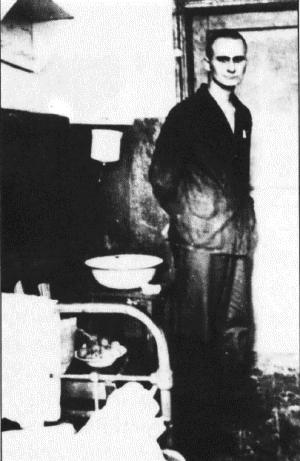
The mother of Soviet prisoner of conscience Anatoly Koplik travelled thousands of kilometres from the Ukraine to visit him in his labour camp near the Soviet-Chinese border in 1977. Before the visit began the head of the camp's 'operation unit' met her. According to a report she prepared after the meeting, the following discussion took place:
'The head of the operations unit scowled and said: "Do you know what kind of trouble is coming?"
'I asked him to explain what he meant by trouble. Some papers were lying on the table and the director of the camp, Pushkin, picked them up and showed me three pages. "Just look," he said, "this is already the second time we're getting these from Amnesty International." I asked him to read out loud what the trouble was. The director summarised what was written: "On account of his religious beliefs A. Koplik did not take the military oath and is serving his sentence in the camp. We urge that he be released and returned to his family, that he be allowed to live in peace, and that his youth be taken into account."
'Hearing this, I asked what the trouble was. The head of the operations unit raised his voice and said, "But do you know what this smells like? Just how do they know his exact address, even his detachment number? How is it that your son has contacts abroad?" I answered these questions with questions of my own: "And what are you surprised about? My son has no foreign contacts. You don't even give him the possibility to write letters home at the allotted times. Many of his letters home you don't even send on."
'The head of the operations unit said, "But do you know who leads this organisation?" I answered: "I only know one thing: my son was condemned and is suffering innocently, and this organisation concerns itself about such people." , Anatoly Koplik was released in August 1979 on completion of his sentence.
